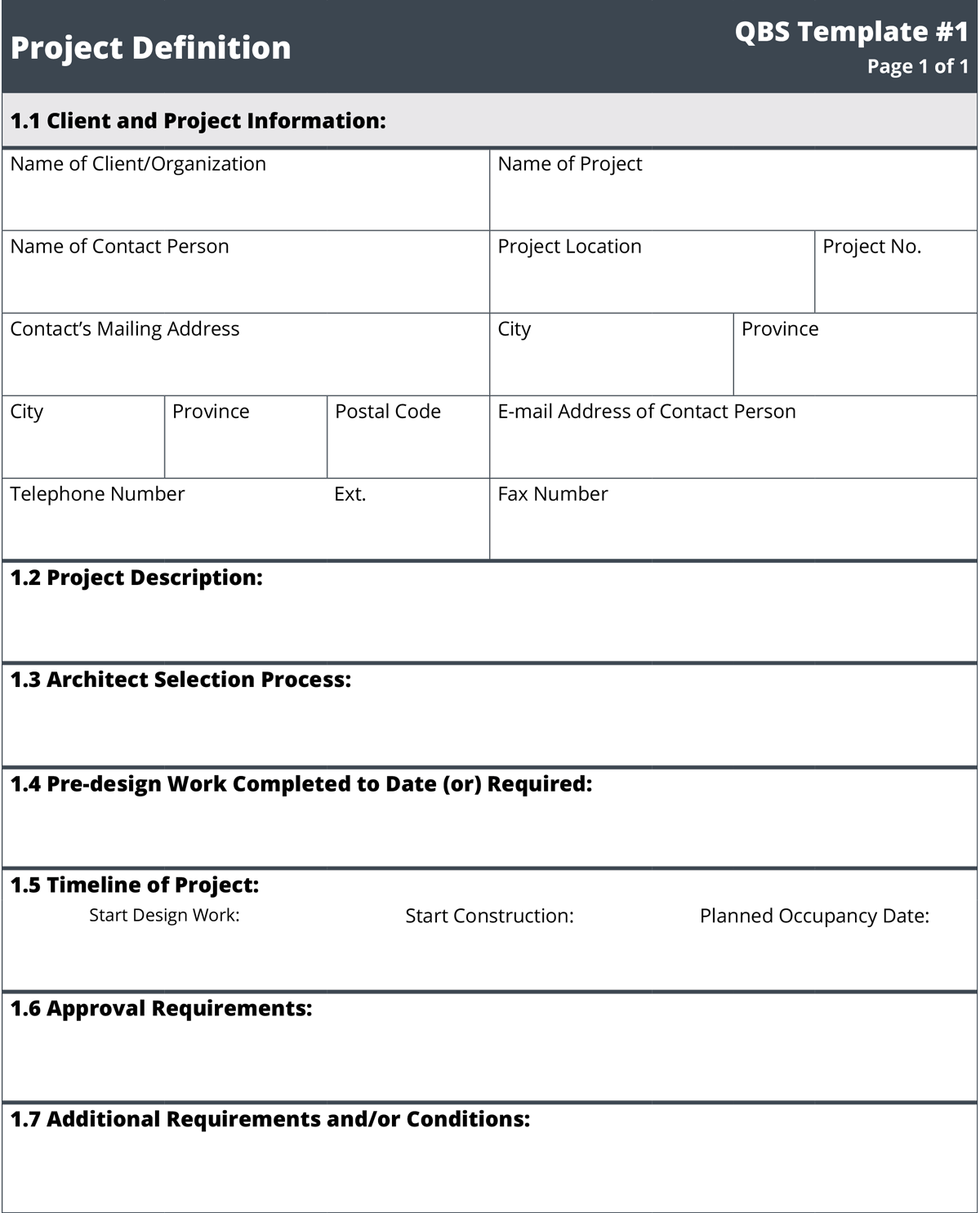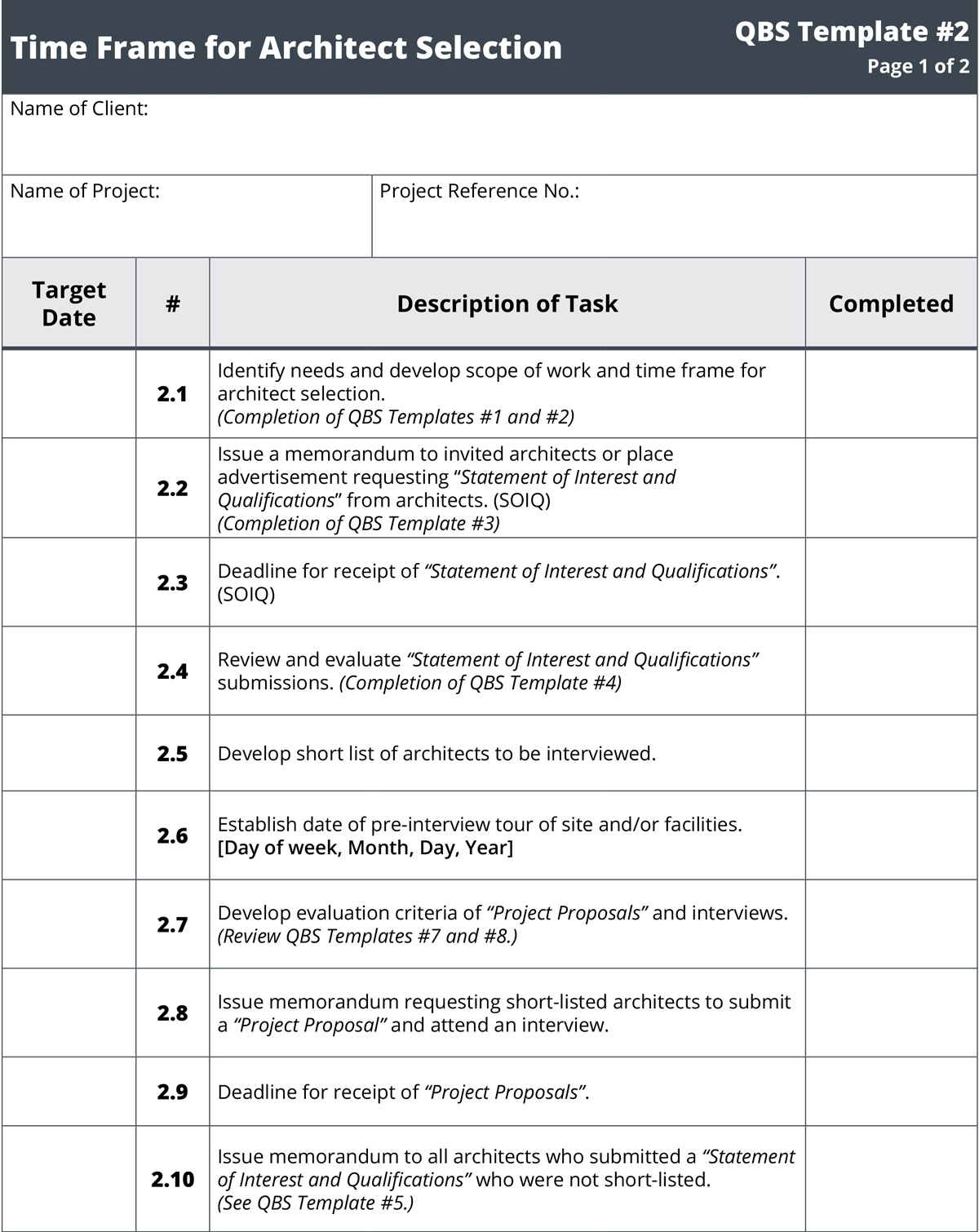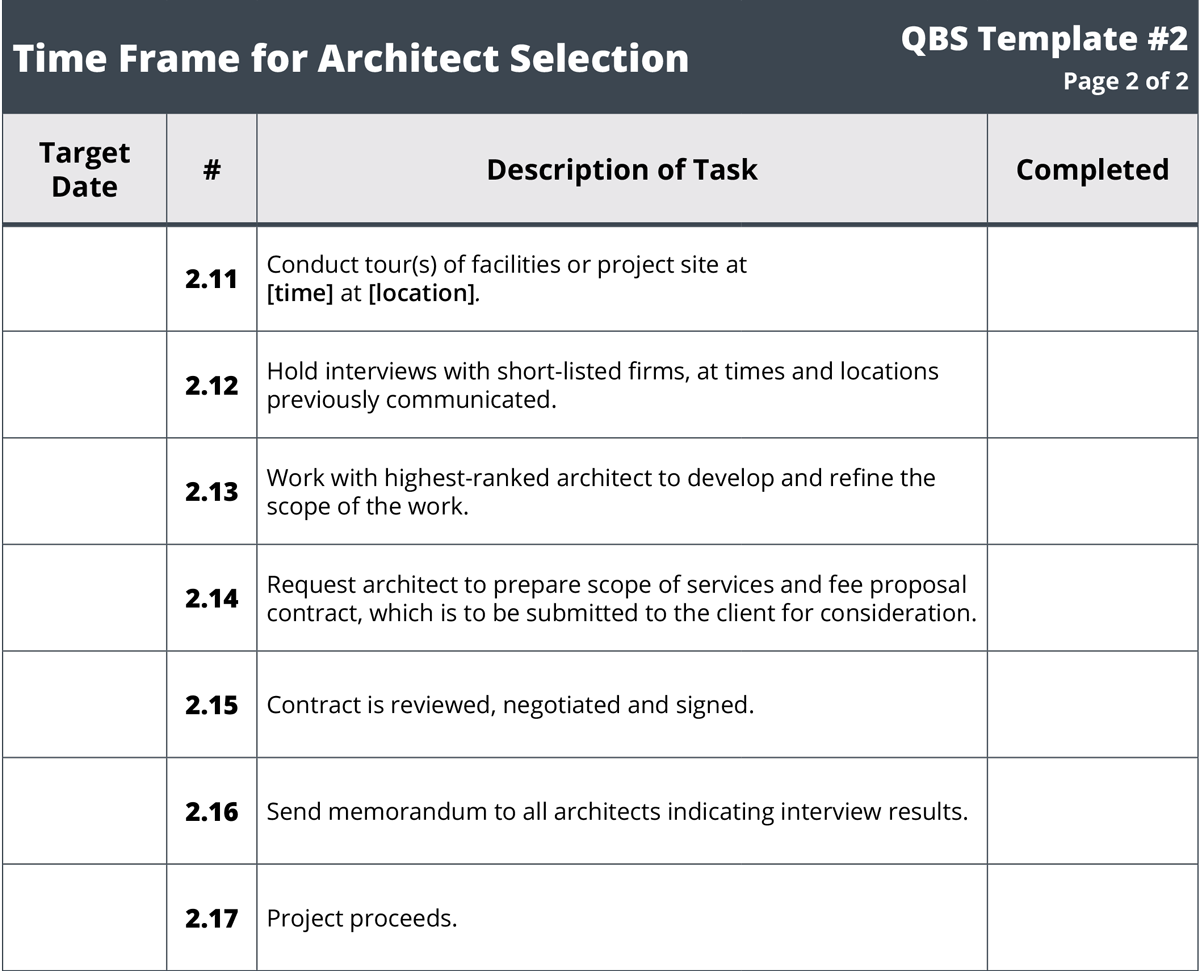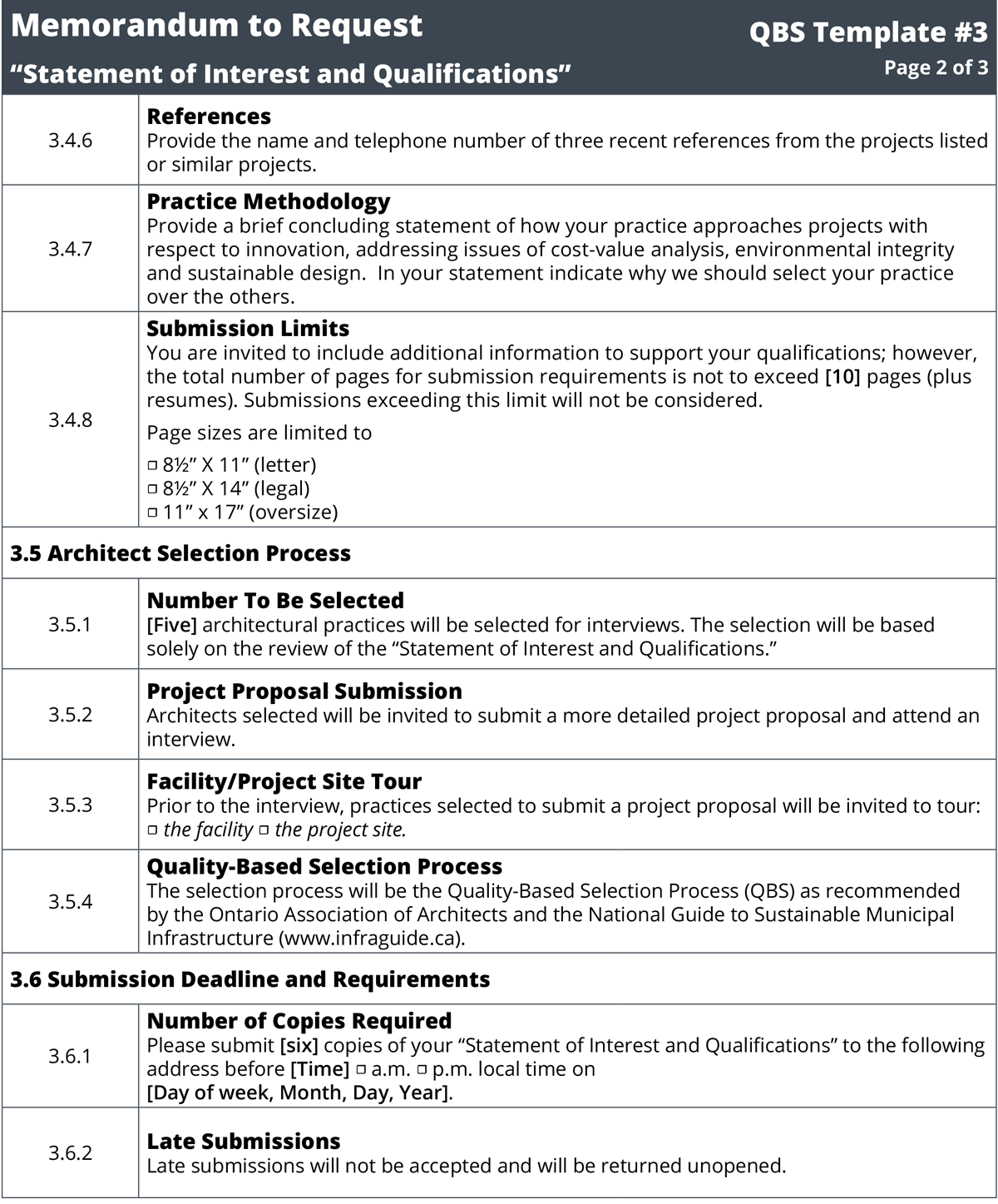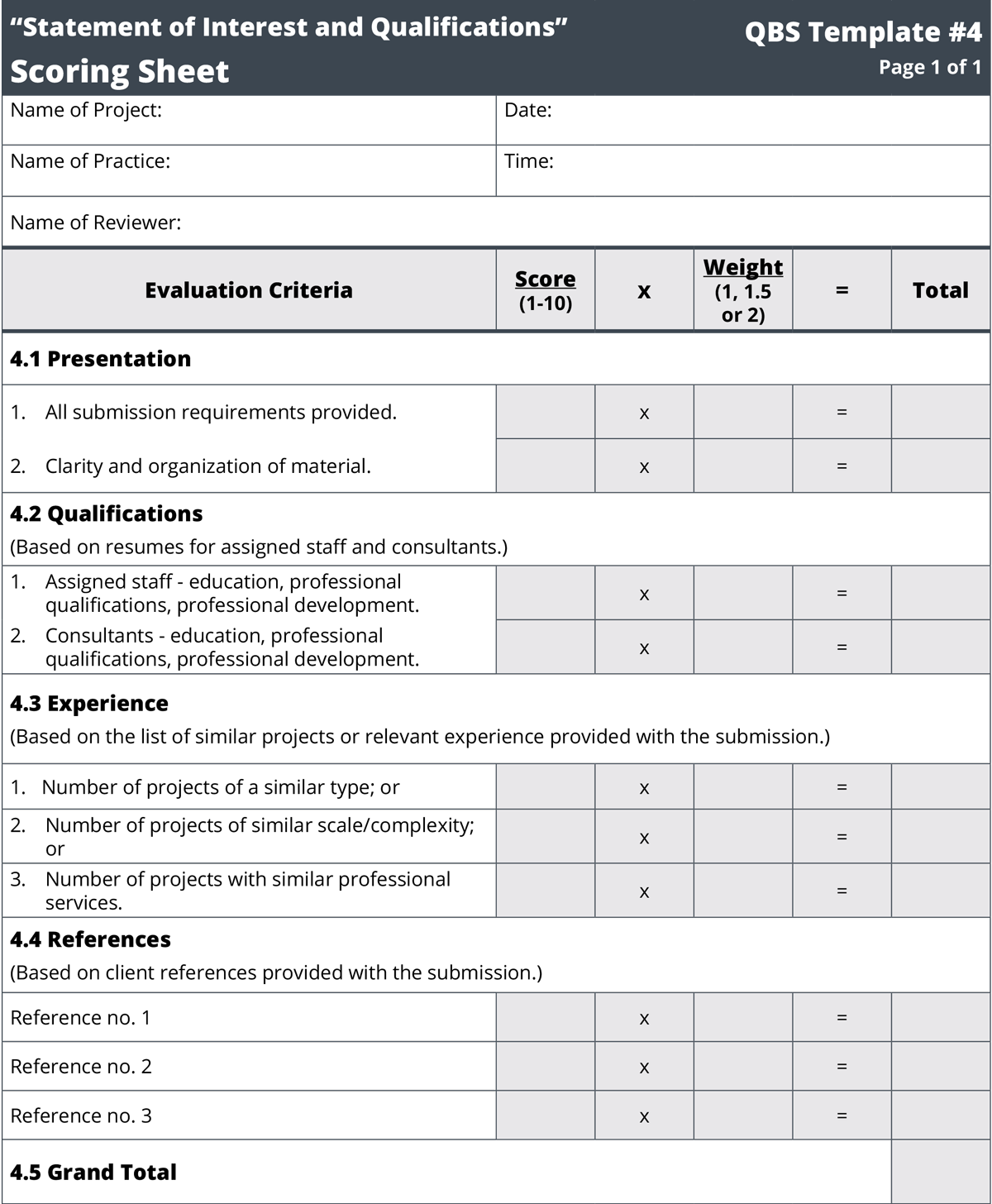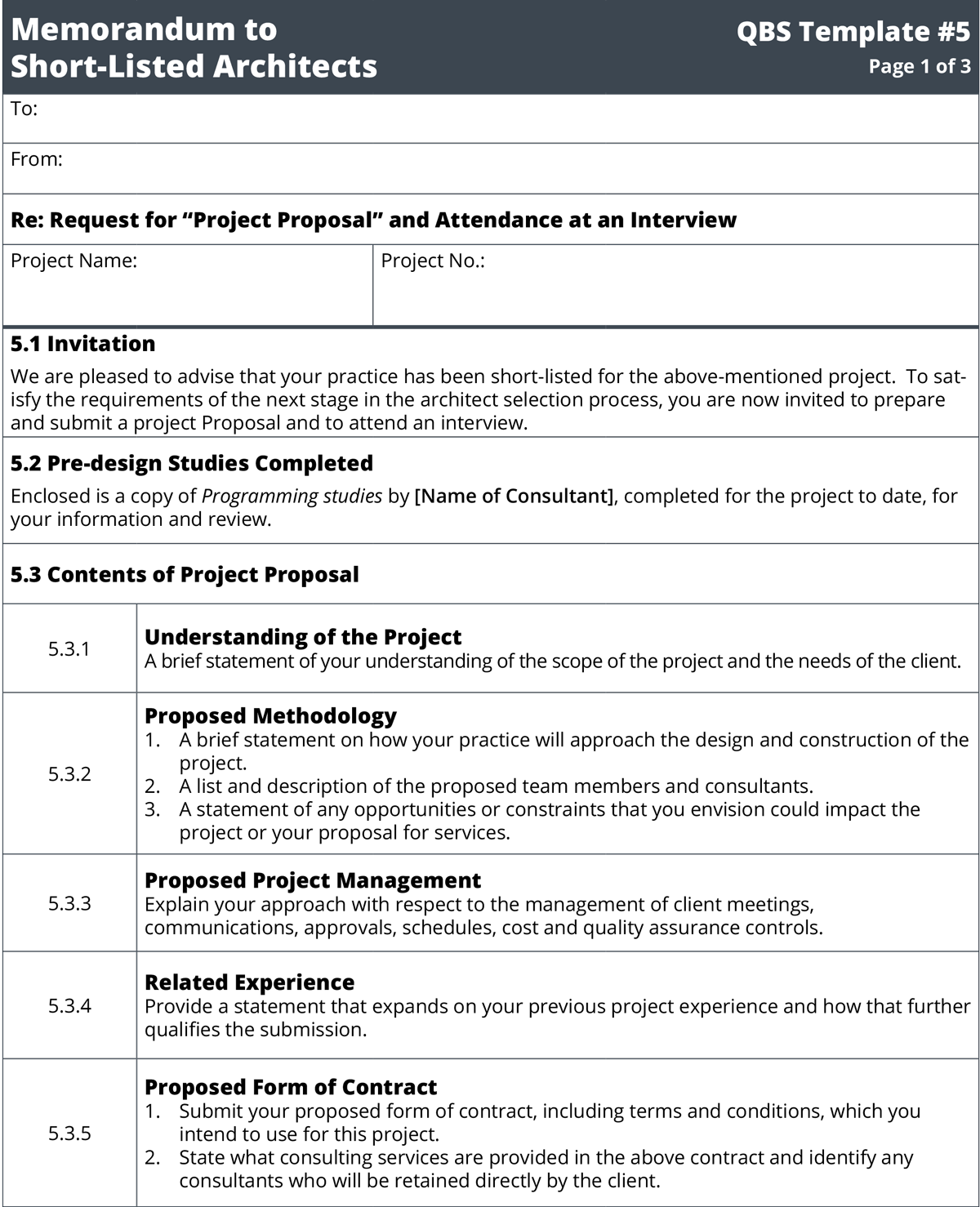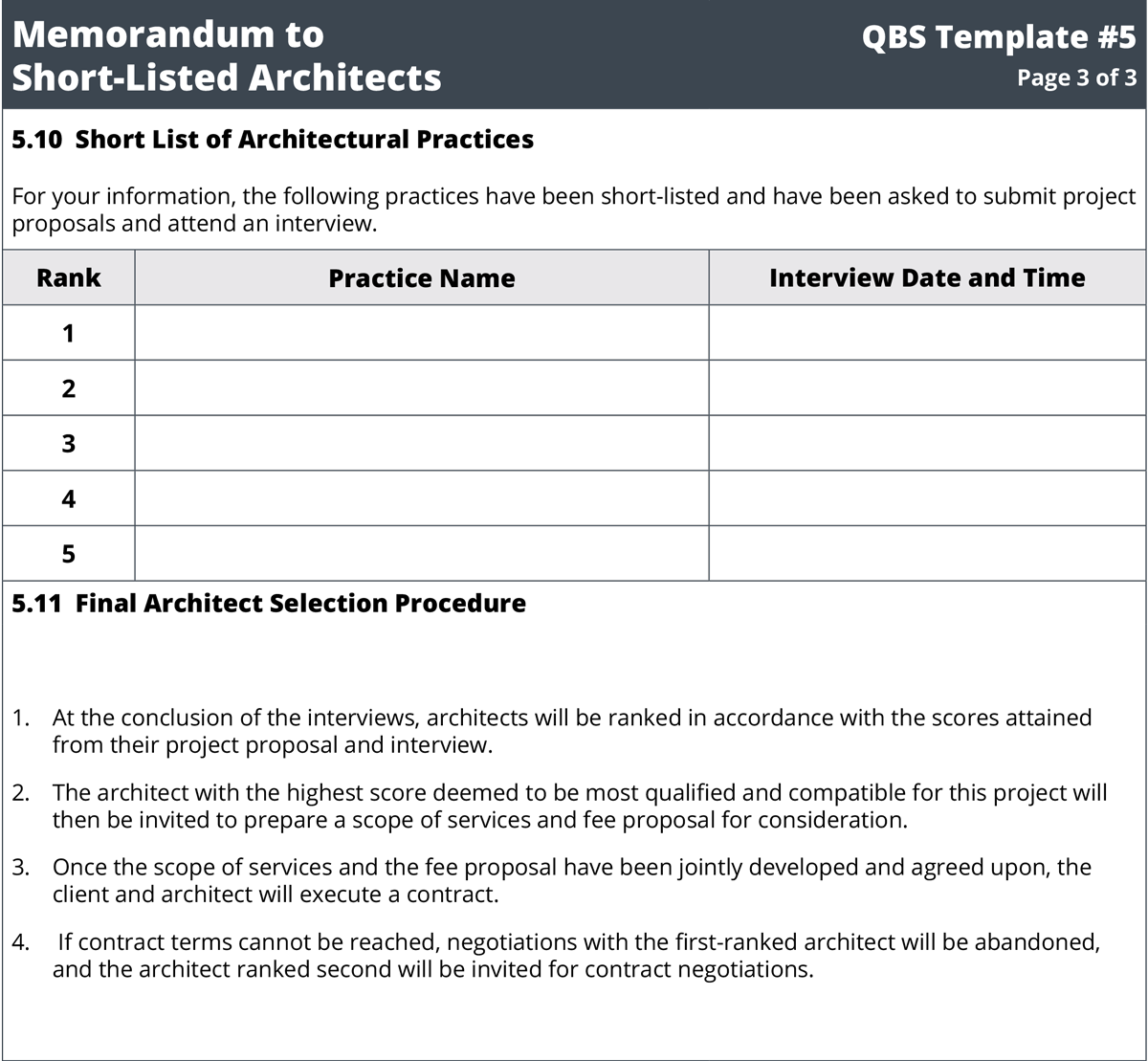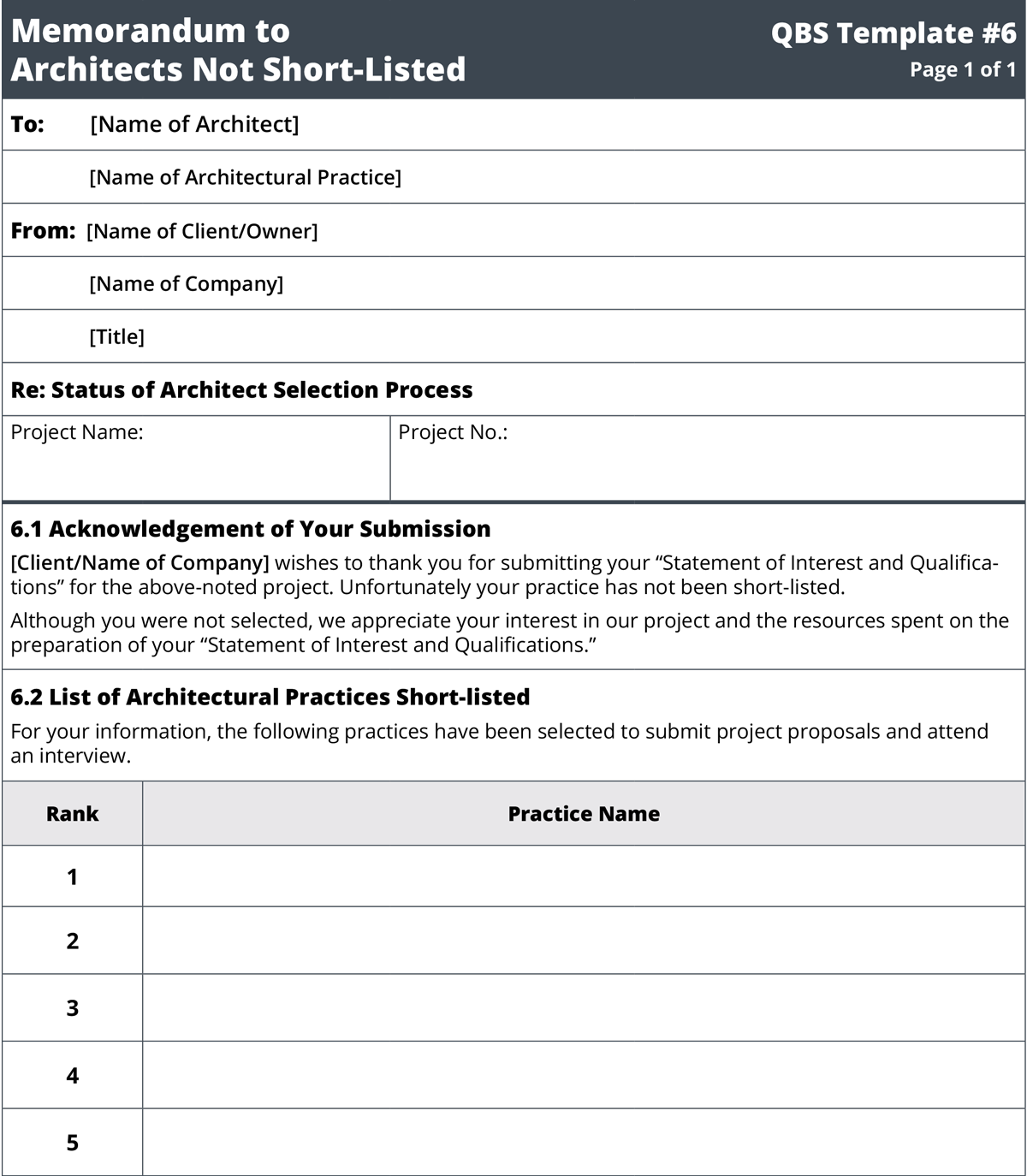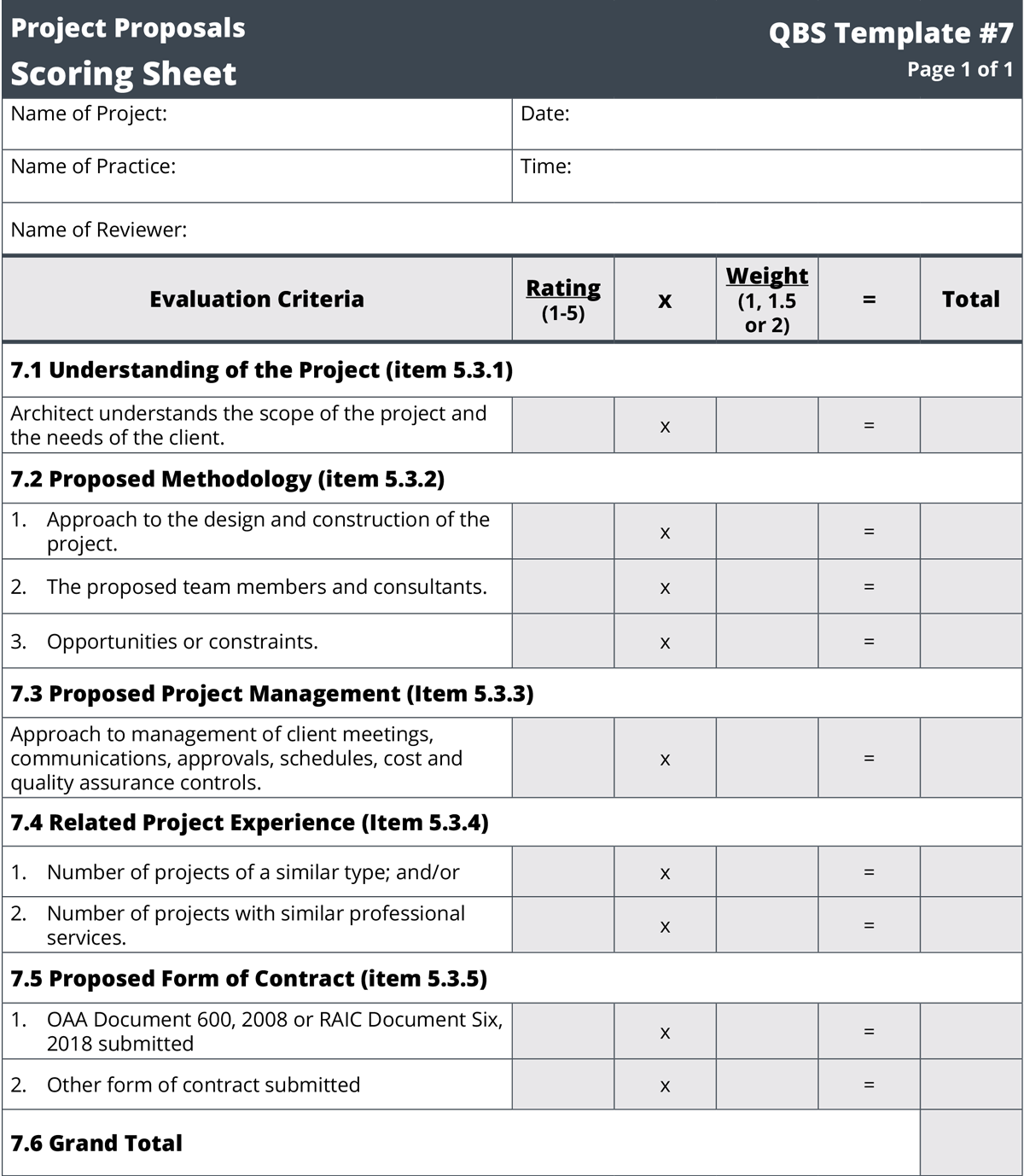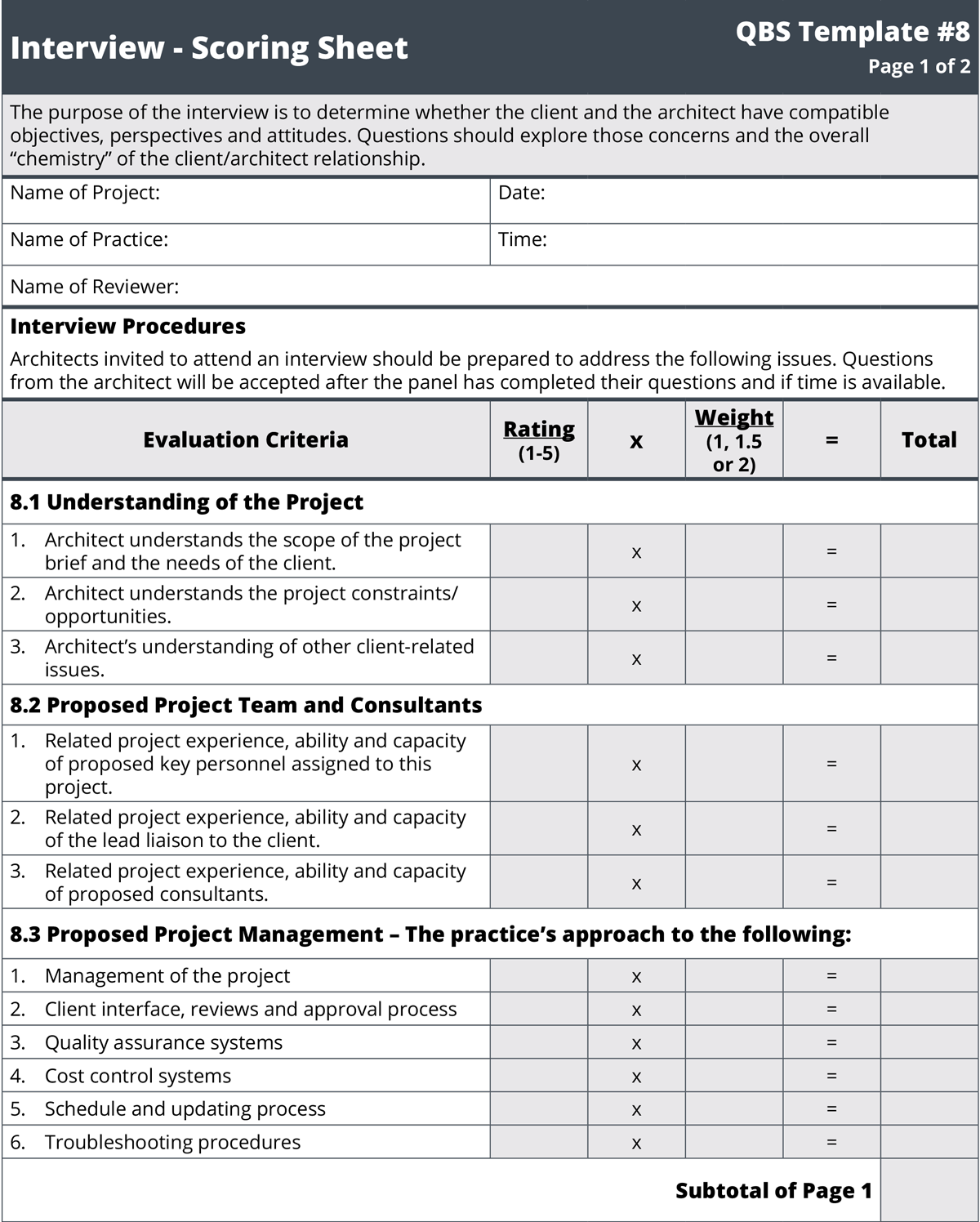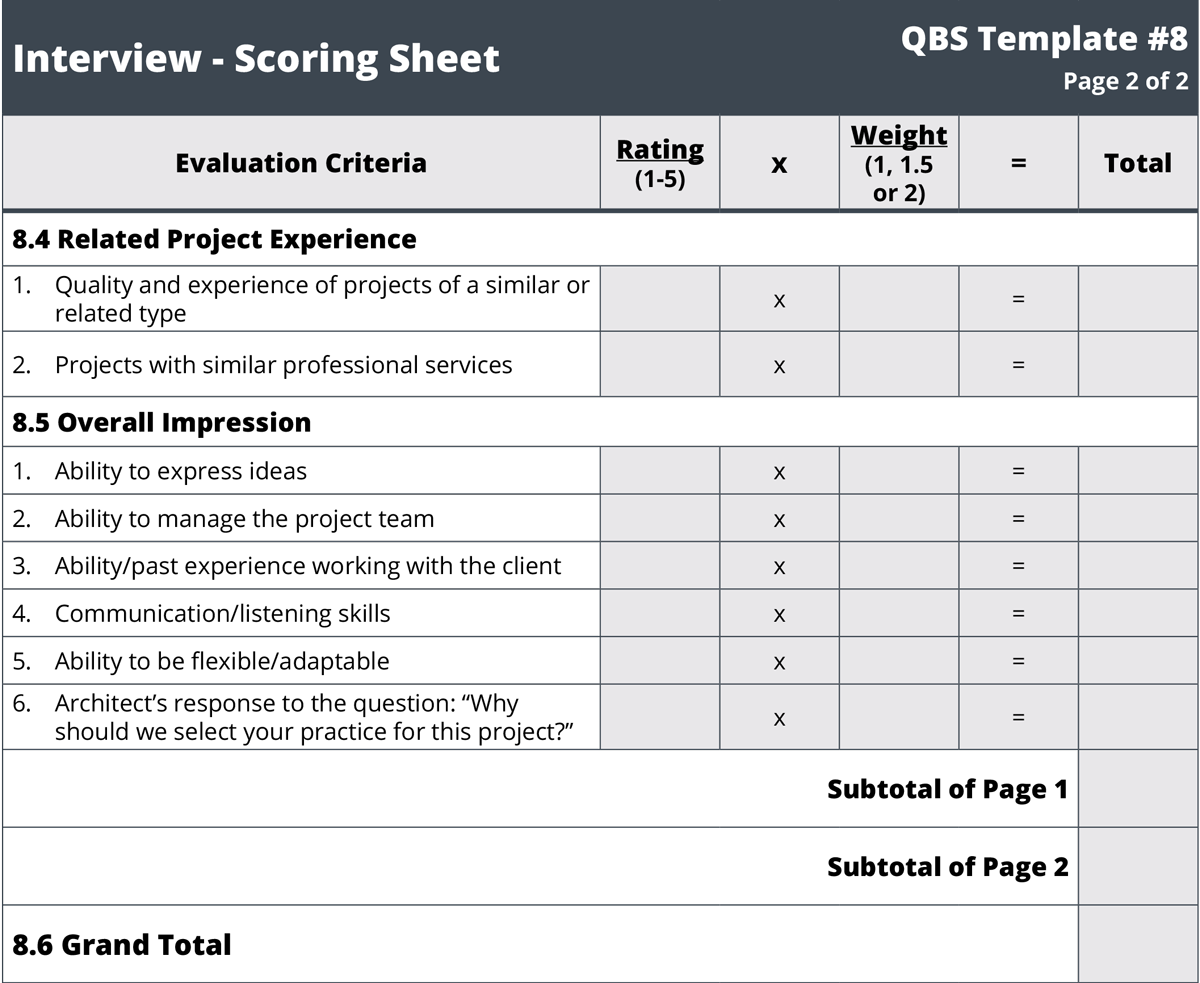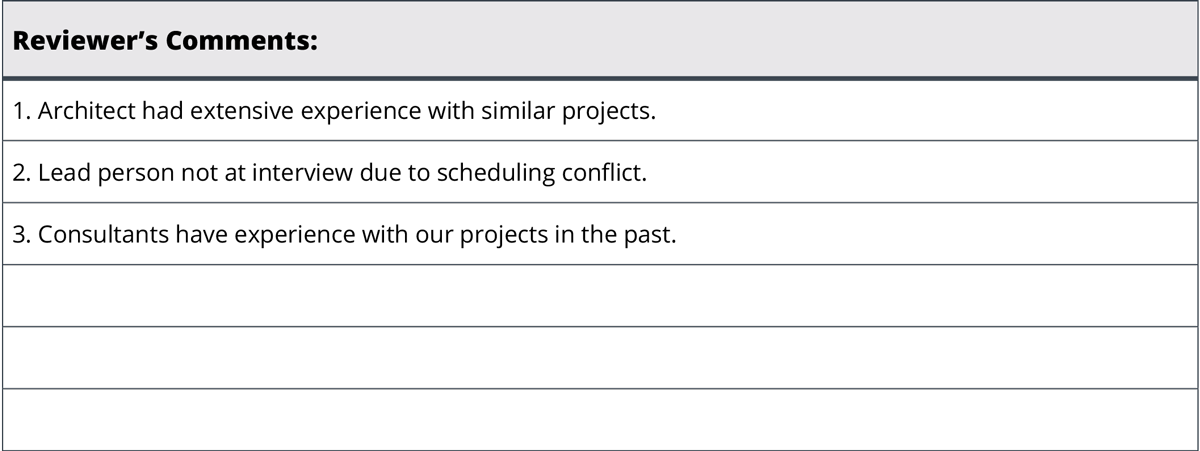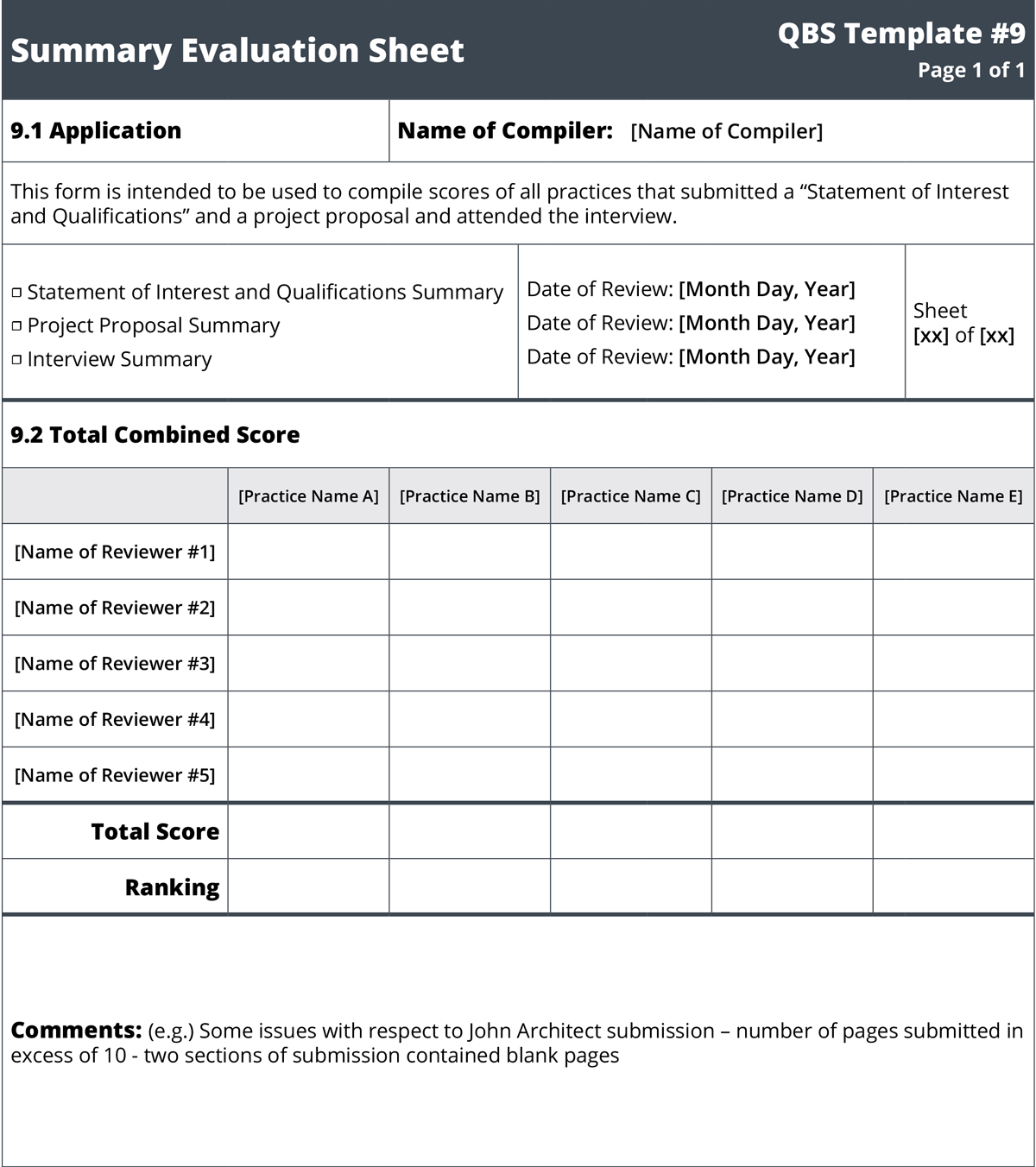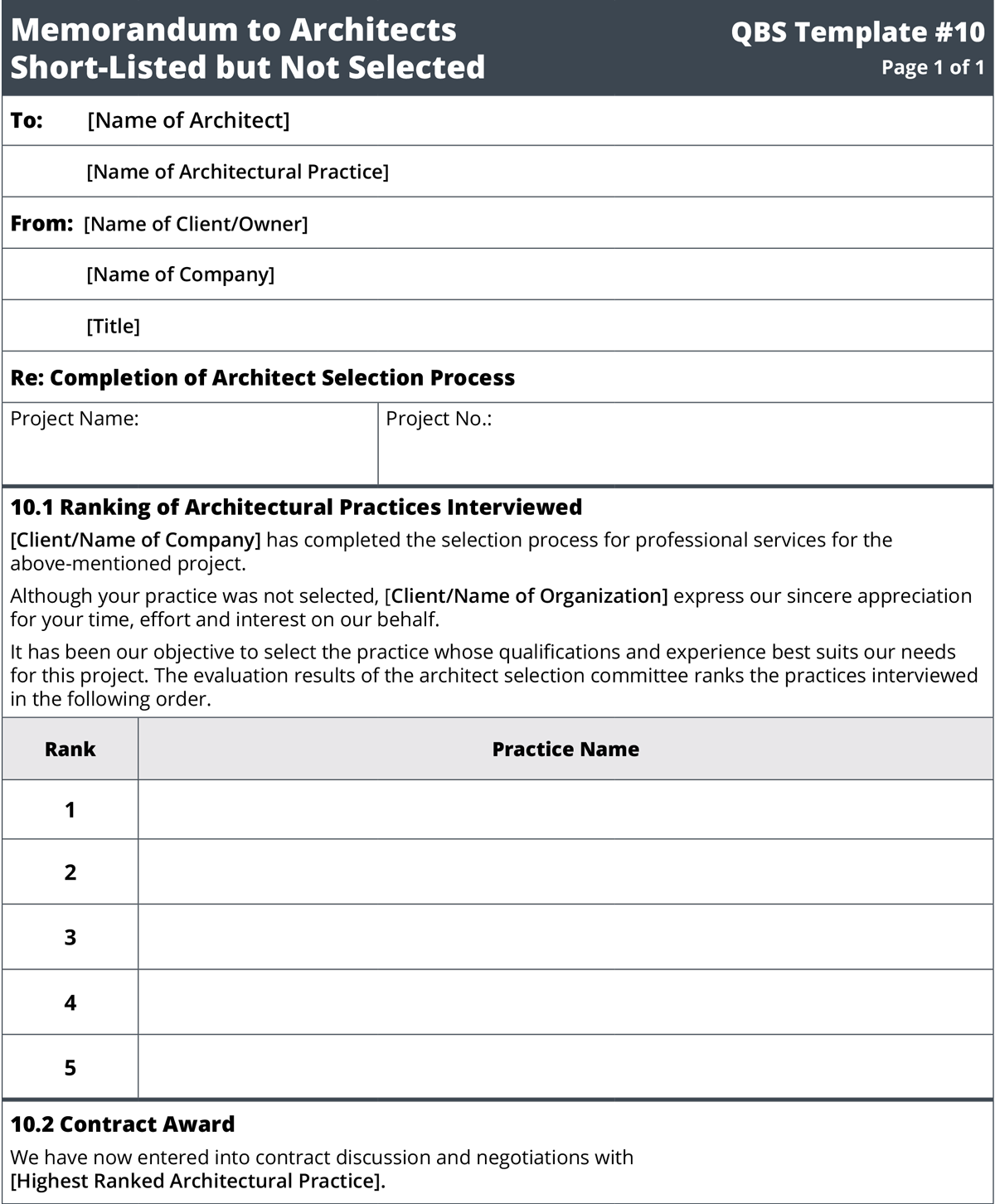The following templates are provided with the permission of the Ontario Association of Architects.
Step 1
The following 10 QBS templates are designed to assist the client during the process of selecting an architect.
- Project Definition
- Time Frame for Architect Selection
- Memorandum to Request a “Statement of Interest and Qualifications”
- “Statement of Interest and Qualifications” Scoring Sheet
- Memorandum to Short-listed Architects
- Memorandum to Architects Not Short-listed
- Project Proposal Scoring Sheet
- Interview Scoring Sheet
- Summary Evaluation Sheet
- Memorandum to Architects Short-listed but Not Selected
General instructions for completing the templates
Editable Word files can be downloaded from the CHOP website. These templates are designed to be used as fill-in forms. The format is a Word Document created on the Word 2003 platform. Each fill-in field is reached by using the “tab” key, typing in the information and then hitting the tab key to advance to the next fill-in field. Some of the fields have default italicized text; these fields can be overwritten, or they can be left as is by advancing to the next field (e.g., the 0 in the year date field 2010). The 0 boxes are checked by clicking them to get 1.
Each template has the protection key turned on so the form can be used as a fill-in form. This can be disabled by clicking on the Lock icon in the “Forms” toolbar. (This toolbar can be added by clicking “View” – “Toolbars” – “Forms”.) This will enable the user to modify the form or to copy the form onto their own letterhead.
When the form is completed, it is recommended that it be saved to a new file name, thereby keeping the original template without the fill-in fields being filled in.
QBS Template #1 – “Project Definition”
Instructions for Completing QBS Template #1 – “Project Definition”
General
This is a one-page general description of the scope of the project and the expectations of the client. It is intended to provide sufficient information to architects to assess their interest and suitability for the project. This document becomes an attachment to the request for a “Statement of Interest and Qualification” from architects.
1.1 Client and Project Information:
Include the following information:
- Legal name of client/organization
- Name of the project and project location (general location will suffice)
- The name of the contact person who will be the prime liaison to the architect
- Contact person’s mailing address, e-mail address, phone and fax number
1.2 Description of Project:
Provide a short description of the project so architects can understand the scale and extent of the project envisioned: for example - new 30,000 sq. ft. 3-storey municipal city hall; or renovation and 10,000 sq. ft. expansion of existing 20,000 sq. ft. 2-storey recreation centre.
1.3 Architect Selection Process:
Identify and describe anticipated involvement of the architect selection group in the quality-based Selection process (for example, boards, committees, citizens’ groups, etc.).
1.4 Pre-Design Work Completed to Date (or) Required:
Provide information regarding any previously completed studies, surveys, feasibility and/or pre-design work relevant to the project. These documents should be made available to architects who will be short-listed and interviewed.
If no previously completed studies have been performed, provide a list of anticipated feasibility studies, planning and/or pre-design services before design work can begin.
- Feasibility Study
- Existing Facility Survey
- Siting Studies
- Budget Analysis
- Program Development
1.5 Timeline:
Indicate the date you expect the architect to commence design work, the date construction is to begin, and the date you expect to gain occupancy to the project. Generally the month-year is sufficient.
1.6 Approval Requirements:
Outline internal and external approvals that will be necessary and describe the involvement of any groups, etc.
1. 7 Additional Requirements and/or Conditions:
List any additional or unique requirements or considerations that will affect the project or the architect (examples: a referendum, public hearings, funding, external approvals, etc.).
The architect selection process needs to be accounted for in the timeline. Provide sufficient time to review submissions, do references checks, conduct site tours, receive project proposals, conduct interviews, refine the scope of the project with the selected architect, review fee proposals and negotiate contract terms.
QBS Template #2 – “Time Frame for Architect Selection”
Instructions for Completing QBS Template #2 – “Time Frame for Architect Selection”
2.0 General
This form is designed to assist the client in developing a preliminary schedule for the architect selection process. It is highly recommended that the schedule be developed at the outset of the project call. Dates should be entered in the left column in MM/DD/YY format.
This form is issued to all architects who receive the client’s request to submit a “Statement of Interest and Qualification.” This information provides the timeline of the selection process so architects can assess the proposed project and respond in a timely fashion to established deadlines.
When completed, this form can also be used to monitor the schedule. As each task is completed, one checks the box in the column on the right side of the form. Should the timeline change after it has been issued to the architects, the form should be updated with a revision footnote and reissued to the architects.
To complete the document:
The legal name of the client should be entered on the first line;
insert the name of the project and a project number if there is one on the second line.
When scheduling tasks, be realistic in assumptions.
The following is a brief list of considerations when planning the schedule. Please note some sections are self-explanatory and are not noted below.
2.1 The first step is the completion of the “Project Definition” form. This fundamental exercise enables the client to communicate with prospective architects what the client needs in the way of professional services. Provide adequate time to circulate this document internally and gain the consensus of all regarding the scope of the work.
2.2 There are two ways to advise architects of the proposed project. One is to contact a select group of architects with whose work the client is familiar. The other way is to open the project call to all qualified architects through newspaper, magazine and/or website advertisements.
Memorandum:
For the client who has a specific list of architects who are to be invited to participate in the project call, the use of the memorandum (QBS Form 3) requesting “Statement of Interest and Qualifications” (SOIQ) will suffice. Keep in mind that, along with the issuance of the memorandum, the completion and issuance of QBS Forms 1 and 2 is also necessary.
Advertisement:
When using electronic, newspaper or magazine media, clients should confirm pre-publication deadlines of the selected publications. Allow adequate time to review and approve the copy prior to publication. In the case of an advertisement, QBS Forms 1 and 2 should be accessible to interested parties. Consider placing the forms on the company website, and make reference to them and the website in the advertisement.
2.3 Establish the deadline date and time for the submission of the SOIQ forms.
2.4 In an invited submission, the review is limited to a finite number of submissions. In an open project call, the number of submissions the client will need to review is unknown until the submissions are actually received.
2.5 In establishing the date for developing the short list of architects, allow adequate time to review and evaluate the SOIQ submissions.
Architect selection is based on value-based criteria, references, and compatibility with the owner’s project.
The short list of architects should be a minimum of three or a maximum of five.
2.6 Establish a date for the project or facilities tour if required. This date should be planned to allow adequate time for architects to attend the site tour, assess the implications, and complete their submissions of the project proposal by the deadline noted in Step 2.8 below.
2.8 Establish the date for architect interviews. When establishing the date, consider allowing adequate time for the client to review and score the submitted project proposals prior to the interview date.
To avoid scheduling difficulties, it is recommended that clients establish the schedule and client interview team early in the selection process; this is to allow for adequate notice to client staff of upcoming reviews and interviews.
In establishing a date for submission of project proposals from short-listed architects, allow a minimum of ten working days from the date the request is received by the architect. If a site tour is required, clients need to allow a minimum of five working days after the site tour to get meaningful project proposal submissions.
2.10 Confirm a date to advise unsuccessful submissions. This task should be undertaken after all successful firms have received their notifications. Inform them of firms to be interviewed and express appreciation for their effort and interest.
2.12 The date of interviews for short-listed firms is established in Step 2.6. If at all possible, interviews of all architects should take place on the same day. For large or complex projects, individual interviews may require additional time and may need to occur over a couple of days.
Allow time for client staff to fill out and compile the scoring sheets for each architect after each interview. Additional time is necessary to rank the architects. Architects are ranked for the project on value-based criteria.
2.13 Provide adequate time from the completion of interviews to engage the highest ranked architect in discussion of the refinement of the scope of work for the project.
2.14 Allow adequate time for the architect to develop the scope of services for the project based upon the defined scope of work. Once agreement on the scope of services is reached, request the preparation of a fee proposal by the architect.
2.15 Allow time to review the fee proposal and to enter into negotiations with the architect if required. This contract needs to be reviewed and executed in a timely fashion prior to the architect commencing work on the project.
2.16 Advise the unsuccessful short-listed architects of the outcome of the interviews and the final selection once the contract with that architect has been executed. Express appreciation for their effort and involvement in the architect selection process.
QBS Template #3 – Memorandum to Request “Statement of Interest and Qualifications”
Instructions for Completing QBS Template #3 – Memorandum to Request “Statement of Interest and Qualifications”
3.0 General
This form is designed to assist the client in advising architects of a potential project and requesting those architects who are interested to submit a “Statement of Interest and Qualification” document for their consideration.
Begin by addressing the memo to the architectural practice.
(Once the form is complete, save the file for that architect, and then just enter the names of the remaining architectural practices individually, saving each one as a separate file.)
The legal name of the client should be entered on the second line.
Insert the name of the project and a project reference number on the third line.
3.2 If there is a preliminary building program or any pre-design studies which were undertaken, they should be listed here. Cite the name of the study and the name of the consultant that undertook the study. Copies of these documents should be made available to the short-listed group of architects.
3.4.10 Define the limit of the number of pages of the submission. An open call can result in a large number of submissions for the client to review. It is recommended to limit the submission to 10 pages. Larger or more complex projects may require additional information for consideration.
State the size of the paper the submission should be on. If this point is not clearly stated, architects can be creative, and some submissions will be on sizes other than standard letter sizes of 8½” x 11”. Specify if pages are to be 8½” x 11” (letter), 8½” x 14” (legal), or 11” x 17” (oversize).
3.5.3 Advise architects if the client is organizing project site tours for those architects short-listed.
3.6.1 Insert the number of copies of “Statements of Interest and Qualifications” required for the client’s internal review process.
Note that if e-mail or facsimile submissions are accepted (see 3.6.5), the number of copies should be limited to one – this means reproducing copies for internal review becomes the client’s responsibility.
Provide a time and date for submissions. Confirm if mailed submissions need to be postmarked by the stated time and date or whether they must arrive at the stated address by the date and time noted.
3.6.3 Provide complete information for where submissions are to be sent.
3.6.4 Provide the necessary information on a contact person within the organization who can address inquiries from architects.
3.6.5 See 3.6.1 for comments about accepting e-mail or fax submissions – provide an e-mail address and/or fax number to which submissions should be sent.
3.6.6 Provide any additional comments or requirements here so that all architects are aware of these concerns.
QBS Template #4 – “Statement of Interest and Qualifications” Scoring Sheet
Instructions for Completing QBS Template #4 – “Statement of Interest and Qualifications” Scoring Sheet
4.0 General
This form is designed to assist the client in scoring the submitted “Statement of Interest and Qualifications” for each submission. If preferred, the form can be printed out and filled in by hand.
Evaluators should evaluate the “Statement of Interest and Qualifications” submissions as follows:
- Ensure that the evaluation criteria are based on the information described in the Memorandum to Request “Statement of Interest and Qualifications” (QBS Template #3).
- Clients are encouraged to define specific issues and concerns and include them in the requirements of the “Statement of Interest and Qualifications” submission. The evaluation form will need to be adjusted to reflect those issues and concerns.
- Adapt this form to the specifics of the project.
- Assign a weight to each of the criteria, up to a maximum of double (2x). This weight should be an indication of the relative importance the client places on the item being evaluated.
- Assemble the team of reviewers prior to the review, and review this form and the specifics of the project with them. Review evaluation criteria and weighting with reviewers.
- Rate each part of the submission on a scale of 1 to 10, with 10 being the highest, and enter the number under “Score.” Incomplete submissions should be disqualified and rejected.
- Client references should be based on client references provided from the list of submitted projects.
- A reference check form should be developed with standard questions and evaluation criteria such as:
- Quality of work – e.g., design, response to client program, contract documentation quality;
- Construction contract administration – bidding, payment certification, deficiencies, change order evaluation, submittal review, project close-out procedures;
- Project management – management of schedule, construction budget.
- Rate each reference check on a scale of 1 to 10, with 10 being an excellent reference.
- A reference check form should be developed with standard questions and evaluation criteria such as:
- When all reference checks have been completed, insert the names and the scores of the three reference checks on the form.
- Multiply each score by the previously established weight to determine the total for each criterion, and then total all the scores to obtain the grand total for that architectural practice.
- Once all “Statement of Interest and Qualifications” submissions have been reviewed, total the scores by all reviewers. This will determine the overall ranking of the submissions. QBS Template #9 – Summary Evaluation Sheet can be used for this purpose; more than one sheet may be required.
- Template #9 can then be used to compile and rank all of the submissions. This form can automatically do the math after entering the individual scores. To do this, put the cursor in the “Total Score” box under each practice. Go to “Table” in the toolbar above; click on “Formula” from the drop-down menu, and find “=Sum(above).” Click OK and the numbers will automatically be summed up for that practice. Ranking will need to be completed by the reviewer based on the totals.
- A short list of architects can now be drawn from the highest-scoring practices.
Notes regarding the remaining Scoring Sheets:
Templates #7, #8 and #9 are all scoring sheets to assist the client during the architect selection process. The process is similar to that used in completing Template #4. The difference is that the “score” is now called “rating,” and instead of a range of 1 to 10 it is now a range of 1 to 5. This is to reflect the nature of the short list of architects, in which reviewers should rank the specific item being reviewed, with 5 being the highest score.

